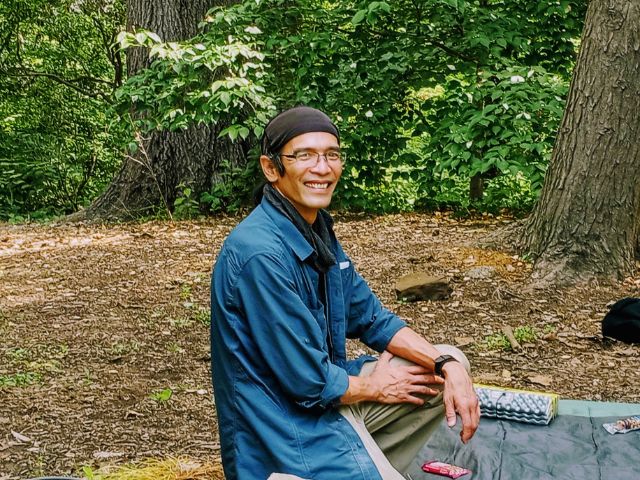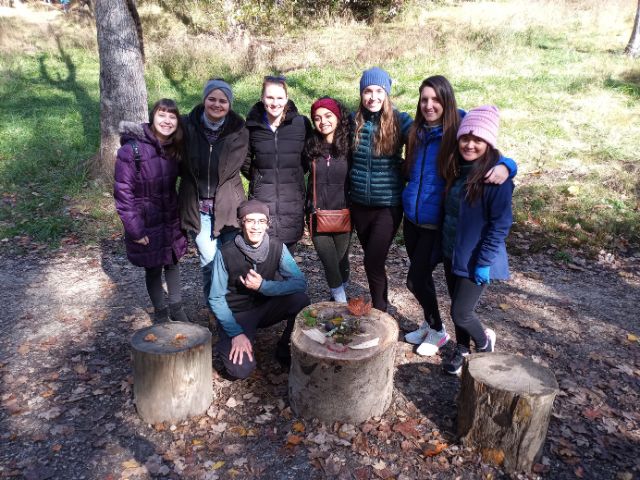
Forest bathing—the term sounds like an extreme sport involving swim trunks, but it’s much simpler than that. In fact, you’ve probably done it yourself; gardening, walking in the park, or even having coffee on your porch, it all counts. While the term has been around since the 1980s, it has recently gained popularity in the United States, especially since the COVID-19 pandemic.
“Forest bathing now is what yoga was back in the 1950s and 60s,” said J. Sage Raindancer, a certified forest bathing guide with the Association of Nature and Forest Therapy (ANFT) and proprietor of Raindancer Healing Arts. “It was a fringe idea at the time, and now everyone knows someone who has practiced yoga, or is even an instructor.”
- Forest bathing (shinrin-yoku) was coined in 1982 in Japan.
- Even 20 minutes in nature can reduce stress, lower blood pressure, and boost immunity.
- Can be done anywhere green—parks, gardens, or your backyard—and doesn’t require hiking.
- Ideal for public lands events, volunteering, and mindful outdoor experiences, with benefits lasting 30+ days.
Raindancer knows firsthand the healing power of spending time in nature. A veteran in the US Army Reserves, he has practiced the healing arts for over 20 years in Arizona, Maryland, Virginia, and Washington, DC, and previously worked as an outdoor skills instructor as part of REI’s Outdoor School. He has led forest bathing sessions with local health care organizations, veterans’ medical centers, community groups, and federal land management agencies such as the National Park Service and USDA Forest Service.
Raindancer shared with us some of the lessons he has learned in his career as a forest bathing guide, as well as some tips for public lands managers and community groups on how they can incorporate forest bathing into their volunteering events.

What is Forest Bathing?
To be clear, there’s no actual bathing involved in forest bathing. There doesn’t even need to be a forest.
“People have asked me if they need to bring their swimsuits,” Raindancer laughed. “The only time you’re ‘bathing’ during forest bathing is if your guide takes you to a body of water and says, ‘Let’s jump in.’”
In 1982, Japan’s Ministry of Agriculture, Forestry, and Fisheries coined the term shinrin-yoku, which loosely translates to “forest bathing” (or, more literally, “being in the atmosphere of the forest”), as part of a national program to improve mental and physical health. Over 67% of Japan’s landmass is covered in forest, making it one of the most forested nations in the world, which is likely why the term was used. However, Raindancer said he prefers “nature therapy” because it’s less ambiguous.
What Happens During Forest Bathing?
Forest bathing is not about hiking the most miles or climbing the highest peaks to achieve enlightenment. It’s simply about slowing down, using your senses, and focusing on the nature around you and how it makes you feel. It’s about disconnecting from the man-made, technological world to focus on the natural one.
“In a nature setting, most animals, whether they’re predator or prey, typically move slower so they can spend their energy observing their surroundings,” said Raindancer. “Forest bathing brings us back to that primal state.”
What happens during a forest bathing session largely depends on who is hosting it. Some guides are trained naturalists, incorporating plant and animal identification and other environmental education strategies into their sessions. Other guides focus more on the therapeutic healing aspect, using musical therapy instruments such as a singing bowl or drum to help participants reach a relaxed, liminal state.
No matter which technique they use, the point is to help participants clear their minds and get in tune with their senses, similar to activities like yoga, meditation, and certain martial arts. Raindancer often uses a technique called a “sit spot,” where he asks participants to find a spot to relax, close their eyes, and then use their senses to observe the nature around them.
“I’ll ask them, ‘What is the closest sound you can hear? The furthest away? Can you feel the sun? Wind? What can you smell, if anything?’” he said.
The session typically concludes by gathering the group together to decompress and discuss their experiences—new things they noticed or thoughts they had.
“The beauty of it is that we [certified guides] have a ‘standard sequence’ to follow, but we also have the freedom to create other activities that fit our personality and the environment,” said Raindancer.

The Mental and Physical Health Benefits of Forest Bathing
Countless studies have explored the effect the environment has on our mental and physical health. A growing body of research has shown that access and exposure to nature is crucial for overall human health and well-being. In fact, just 20 minutes in a forested space is enough to produce positive changes in the body.
The cause of these positive changes is attributed to phytoncides (wood essential oils) that are produced by trees and aerosolized in a forest setting. Phytoncides have been shown to improve human immune function, reduce cortisol (stress) levels and blood pressure, and stabilize prefrontal cerebral activity.
Test results conducted after a forest bathing trip showed significantly increased scores for vigor and decreased scores for anxiety, depression, and anger, suggesting that the subjects were both mentally and physically relaxed during their time in the outdoors. These effects can last for more than 30 days after a trip to the forest.
Tips for Hosting Your Own Forest Bathing Activity
If you’re looking for a way to encourage visitors to develop a deeper connection with your public lands site, or just want to provide some variety at your next National Public Lands Day (NPLD) event, forest bathing is a great place to start! With a low barrier to entry, flexible format, and tangible health benefits, you can customize this activity to fit your space and the needs of your attendees.
Here are some top tips to keep in mind when developing your next forest bathing activity:
Consider Your Location
Location plays a major role in forest bathing. The area you choose doesn’t need to be somewhere in the remote wilderness, but it shouldn’t be a parking lot, either.
Raindancer says what’s most important is to find some sort of separation from the built environment. Barring that, he suggests that organizers “can always bring the outside inside.” For example, you could host a forest bathing exercise at your local park’s visitors center or area natural history museum, using their exhibits on local flora and fauna as a primer for what to expect when participants do venture outside.
Distance Doesn’t Matter
Raindancer often conducts forest bathing sessions at the US National Arboretum in Washington, DC, which has many magnificent collections of different types of trees and plants. However, instead of attempting to cover all 446 acres, he will often stick to one collection at a time, sometimes traveling less than a quarter mile in total.
“The distance doesn’t matter, it’s the journey,” said Raindancer. “Even if it’s a short 45-minute walk, there’s still a way to have an experience with nature that is very uplifting.”
Develop Activities That Engage the Senses
A successful forest bathing session allows participants the time and space to connect with nature on their own terms while also providing some gentle guidance to help them reach those “aha!” moments.
Think about the natural features of your public land site and incorporate them into the session—listen to the sound of a nearby creek, smell the fresh pine needles, taste the salty sea air. Even man-made noise and other stimuli in an urban park setting can be something to focus on.
Raindancer also suggests activities that foster a “childlike curiosity” in participants.
“For example, you could walk people through the animal exhibits inside a nature center, then take them outside and ask, ‘What was your favorite animal? OK, imagine you are that animal,’” said Raindancer. “‘Where would you go? What would you do? Let’s build a shelter as if you were that animal.’ It gives them a different perspective outside of their human one.”
Leave Time for Sharing (and a Snack)
As with any good environmental education activity, you should always provide a space for participants to share their findings with the group.
“It’s important that we share our stories and observations because that’s something our ancestors have done for ages,” said Raindancer. “It was necessary for survival, but it was also a way of life, finding these connections with the world around us.”
While you’re focusing on your participants’ mental needs, you shouldn’t neglect their physical ones, either. Raindancer likes to provide a small snack for the group at the end of a session to give them the energy they need for proper discussion.
“Engaging our minds and senses can be a lot of work,” said Raindancer. “And sometimes, you just need a snack.”
Try Using a Certified Forest Bathing Guide
Following the advice above, anyone can host their own forest bathing session. However, for participants to get the most from the experience, Raindancer suggests hiring a certified forest bathing guide.
“Do you have to be a licensed massage therapist to give someone a massage? No, but it helps if you know what you’re doing,” he said.
The ANFT has an online directory of guides sorted by location. You can also ask within your community to see if anyone knows a guide or has experience hosting similar events. Consider reaching out to local mental health organizations, parks and recreation associations, and your state’s department of agriculture as well.
Try Forest Bathing at Your Next Volunteering Event
Forest bathing provides the perfect opportunity to get visitors interested in exploring your public lands site at their own pace. It can be used as a regularly scheduled standalone activity or in conjunction with a larger volunteering project, offering a low barrier to entry for children, older adults, and people with limited physical abilities.
Forest bathing is just one of the many activities taking place as part of the 2024 National Public Lands Day Signature Event at the Washington Youth Garden in the US National Arboretum in Washington, DC, hosted by NEEF and the USDA Forest Service. Raindancer himself will be attendance to lead several guided forest bathing sessions in and around the garden. If you are in the greater Washington, DC, area, please consider stopping by from 11 a.m. to 1 p.m. on Saturday, September 28!
You can learn more about the Signature Event here, and for more tips on how to host a successful NPLD event, visit our NPLD for Site Managers page.
